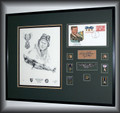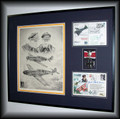 Loading... Please wait...
Loading... Please wait...Categories
Our Newsletter
- Home
- Combat Aircraft/Pencil Drawings ~ Free Shipping
- Focke Wulf ~ FW190D-9 'Dora' ~ Free Shipping
Product Description
***CLICK ON IMAGE TO ENLARGE***
Print Size 8½ x 11 ----- Unlimited print edition
The Fw 190D (nicknamed the Dora; or Long-Nose Dora, "Langnasen-Dora") improved on the A-series enough to make it useful against the American heavy bombers of the era. The liquid-cooled 1,750 PS (1,726 hp, 1,287 kW) Jumo 213A could produce 2,100 PS (2,071 hp, 1,545 kW) of emergency power with MW-50 injection, improving performance to 426 mph at 21,650 feet. At the time it was expected the D models would replace the A series outright on the production lines, so the first version was called the Fw 190 D-9, the A-8 being the current production model. Supply problems with the Jumo 213 forced the A model to remain in production longer than expected, making this re-naming effort superfluous. Due to the multiple attempts to create an effective next generation 190, as well as the comments of some Luftwaffe pilots, expectations of the Dora project were low. These impressions were not helped by the fact that Tank made it very clear that he intended the D-9 to be a stop-gap until the Ta 152 arrived. These negative opinions existed for some time until positive pilot feedback began arriving at Focke-Wulf and the Luftwaffe command structure. Sporting excellent handling and performance characteristics, it became very clear that the D-9 was nearly the perfect response to the Luftwaffe's need for a high-altitude, high-speed interceptor. When flown by capable pilots, the Fw 190D proved to be a match for P-51s and Mk. XIV Spitfires. In most World War II pilot circles the D-9 and the similar Ta 152 were considered the pinnacle of German piston engined aircraft. In order to fit the new engine in the Fw 190 fuselage while maintaining proper balance and weight distribution, both the nose and the tail of the aircraft were lengthened, adding nearly 1.52 meters to the fuselage, bringing the overall length to 10.192 meters versus the 9.10 meters of the late war A-9 series. The tail lengthening was accomplished with an added fuselage section, spliced in-between the complete tail unit's front mating line and the extreme rear of the fuselage. This gave the rear fuselage a much "skinnier" appearance. Furthermore, the move to an inline engine required more components to be factored into the design, most significantly the need for coolant radiators (radial engines are air-cooled). To keep the design as simple and as aerodynamic as possible, Tank used an annular radiator installed at the front of the engine, similar to the configuration used in the Jumo powered versions of the Junkers Ju 88, which gave the appearance that the D-9 was still a radial engine-powered aircraft. While the first few Doras were fitted with the flat-top canopy, these were later replaced with the newer rounded top "blown" canopy first used on the A9 model. Some late model Doras were also fitted with the Ta 152 vertical stabilizer and rudder, offen called "Big Tails" by the Luftwaffe ground crews and pilots. As it was used in the anti-fighter role, armament in the "D" was generally lighter compared to that of the earlier aircraft usually the outer wing cannon were dropped so that the armament consisted of two 13 mm MG 131 machine guns and two 20 mm MG 151/20E wing root cannon. What little it lost in roll rate, it gained in turn rate, climb, dive and horizontal speed. The Dora still featured the same wing as the A-8, however, and was capable of carrying outer wing cannons as well, as demonstrated by the D-11 variant, with a three-stage supercharger and four wing cannon (two MG 151s and two MK 108s). Some Fw 190Ds served as fighter cover for Me 262 airfields as the jet fighters were very vulnerable on takeoff and landing. These special units were known as Platzsicherungstaffel (airfield defense squadron). One unit in particular was created by Leutanant Heinz Sachsenberg at the behest of Adolf Galland, had the entire aircraft underside painted in red and with white stripes. The unique color scheme helped anti-aircraft artillery protecting the airfields quickly identify friendly aircraft, and may have been based on the D-Day invasion stripes used by the Allied air forces. The unit, known as Würger-Staffel, guarded the airfield of JV 44, operational late in the war, from about March 1945 to May 1945, and was used only to defend landing Me 262s and as such prohibited from chasing Allied aircraft.
Warranty Information
null








